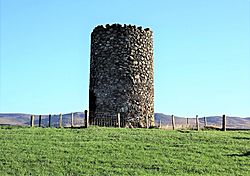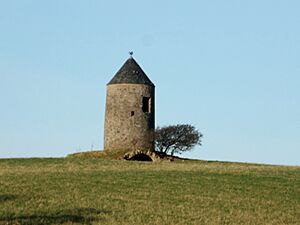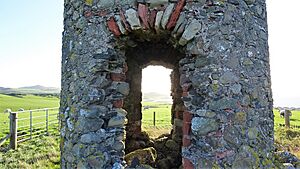Ballantrae Windmill facts for kids
Quick facts for kids Ballantrae Mill, Ballantrae |
|
|---|---|

The Ballantrae Windmill
|
|
| Origin | |
| Mill name | Ballantrae Vaulted Tower Mill |
| Mill location | Ballantrae, South Ayrshire |
| Grid reference | NX090832 |
| Coordinates | 55°06′23″N 4°59′43″W / 55.1065°N 4.9953°W |
| Operator(s) | Disused |
| Year built | Late 17th or early 18th Century |
| Information | |
| Purpose | Meal mill |
| Type | Vaulted Tower Mill |
| Storeys | Two |
| No. of sails | Four |
| No. of pairs of millstones | 1 |
The Ballantrae Windmill is an old windmill found on Mill Hill, near the village of Ballantrae in South Ayrshire, Scotland. It was built a very long time ago, around 1696, and stopped working by 1799. Even though it's now a ruin, it's a very important building. It's called a Category A Listed Building because it shows us a lot about early industrial times.
Contents
What is the Ballantrae Windmill?
The Ballantrae Windmill is a special type of windmill called a vaulted tower mill. It was built in the late 1600s or early 1700s. Today, only the stone tower remains. You can find its ruins above the old sea cliffs outside Ballantrae village.
How was the Windmill Built?
The windmill's tower is about 7 meters (24 feet) tall. Its walls are very thick, about 0.9 meters (3 feet) at the bottom. These walls were made from local stones. These stones came from nearby fields, a quarry, and even from the beach.
The windmill used to have a wooden cap on top and large sails. These parts are now gone. The tower likely used to be taller and might have gotten narrower towards the top. This design helped keep the tower stable.
Special Features of the Tower
The tower has some interesting parts. It has two doorways, one on the north side and one on the south. Above these doors, there are two small windows on what was once the first floor.
Inside, there was a special vaulted basement. This was a room with a curved, arch-like ceiling. There are also unusual arches built into the tower walls. These "relieving arches" helped make the structure stronger.
Most of the outside covering that protected the mill from water has worn away. This means many stones are now loose. An old map from 1821 shows that the mill once had a fence or wall around it.
How Did People Get to the Mill?
There was a sunken path that led into the vaulted basement from the west side, which is the cliff side. It's not clear exactly how the main path connected to the mill. However, people likely used horses and carts to bring grain to the mill. A small stream used to flow nearby, but it's now covered up.
When Was the Ballantrae Windmill Used?
The Ballantrae Windmill is thought to have been built in 1696. This type of vaulted tower mill is quite rare in the United Kingdom, except in Scotland. The first map showing the Ballantrae Mill was made in 1747.
Windmills were often built in places where there wasn't much rain or where the land was flat. In coastal areas like Ballantrae, windmills were useful because there were usually strong winds all year round.
The mill is shown on a map from 1747 by Roy. Another map from 1775 by Armstrong clearly shows the windmill with four sails. However, by 1799, records show that the windmill was already a ruin.
How Did the Windmill Work?
This kind of windmill had a fixed stone tower with a movable cap on top. This cap held the sails. Workers had to turn the cap by hand using a long pole to make the sails face the wind. This meant someone had to be there all the time to adjust it. They could also change how tight the sails were to match the wind speed.
The tower was built on a small hill over a stone-built vaulted room or cellar. This cellar often extended out from the base of the mill. It acted as a third floor where grain could be brought in and flour could be taken out.
Most Scottish windmills, like watermills, were used to grind grain. They mainly made flour from wheat and oats, and also ground barley and crushed corn.
What Does the Site Look Like Today?
Today, the north and south doorways of the mill are open. The vaulted basement is in poor condition. It has been partly broken down and filled in to stop animals from entering. The inside of the tower is mostly filled with stones. Only two small windows remain.
There are no parts of the original windmill machinery left. The outside covering and mortar have fallen off, and the mill is on a list of buildings at risk. The tower is about 2 meters (6 feet) shorter than the one at Monkton. A drawing from 1930 suggests it was taller and tapered more back then.
Only twelve vaulted tower windmills still exist in Scotland. These are some of the oldest industrial buildings in the country. The Ballantrae Windmill is special because it hasn't been changed for other uses. This makes it one of the best examples of its kind.
Images for kids






